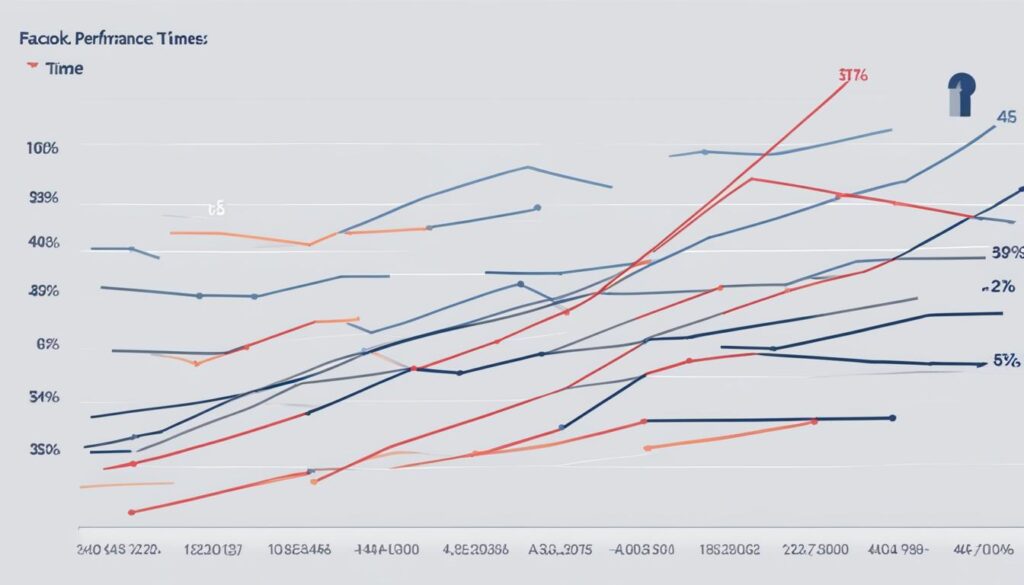Facebook is a powerful platform for advertising your business to a vast audience, but creating a successful advertising campaign can be challenging. Attracting the right audience and achieving your ad objectives requires careful planning, execution, and monitoring. In this guide, we’ll walk you through the essential steps and strategies to create a successful Facebook advertising campaign for your business in the US market.
Key Takeaways
- Creating a successful Facebook advertising campaign requires a well-defined strategy.
- Optimization and analysis are crucial to maximize the effectiveness of your campaigns.
- Captivating ad creatives are essential to grab attention and drive engagement on Facebook.
- Effectively managing your ad budget is crucial to maximizing return on investment (ROI).
- Facebook offers a wide range of targeting options to help you reach your desired audience.
Understanding Facebook Advertising Basics
Before you jump into creating a successful Facebook advertising campaign, it’s crucial to understand how Facebook advertising works and its basic concepts. Facebook advertising is a highly effective way to reach your target audience and promote your brand, product, or service.
Facebook advertising is an advertising campaign that uses Facebook as a platform to showcase your ads to a specific audience. You can create your ads and target them to the right audience based on demographics, interests, and behaviors.
The Facebook advertising campaign is created with an objective. The objective can be to drive traffic to your website, increase brand awareness, generate leads, or boost sales. You can set up your budget and bid for each ad placement.
Key Concepts of Facebook Advertising
Here are some of the key concepts that you should know before setting up your Facebook advertising campaign:
- Ad Set: A group of ads that share the same budget, schedule, and targeting settings.
- Target Audience: The specific audience you want to reach with your ads based on demographics, interests, and behaviors.
- Bidding: The process of setting up your budget and bidding for each ad placement based on the reach, impressions, or clicks. You can choose automatic or manual bidding.
- Ad Placement: The location on Facebook where your ads will appear, such as News Feed, Right Column, or Stories.
By understanding the basic concepts of Facebook advertising, you can create a successful advertising campaign and achieve your marketing objectives.
Defining Your Advertising Strategy
Facebook marketing provides businesses with a unique opportunity to target their marketing efforts towards specific demographics. But before you dive into creating your Facebook ad campaign, you need to define your advertising strategy. This will help you make informed decisions about the ad targeting and ad creative that you will use to reach your target audience.
Ad targeting is the process of identifying the specific demographics that you want to reach with your Facebook ads. You can target your audience based on factors such as age, gender, location, interests, and behaviors. This makes it easier to deliver your ads to the people who are most likely to engage with them.
| Targeting Options | Description |
|---|---|
| Location | You can target ads to people who live in a specific area, or who are visiting a particular location. |
| Interests | You can target ads to people who have shown an interest in specific topics, such as sports, music, or food. |
| Behaviors | You can target ads to people based on their past behaviors, such as their purchasing habits or the devices they use to access Facebook. |
Ad creative is the content that you use in your ads, such as images, videos, and text. Your ad creative needs to be attention-grabbing and relevant to your target audience. It should also be aligned with your overall brand messaging and values.
Campaign optimization is the process of refining your advertising strategy to maximize your campaign’s performance. This involves monitoring your ad metrics and making adjustments to your targeting and creative based on the results. By doing so, you can ensure that your Facebook advertising campaign is achieving your desired objectives.
By defining your advertising strategy, you can set clear goals and make informed decisions about your target audience, ad creative, and campaign optimization. This will help you create a successful Facebook advertising campaign that resonates with your target audience and delivers results for your business.
Optimizing Your Facebook Ad Campaign
Once you have defined your advertising strategy, it’s time to optimize your Facebook ad campaign to achieve the best results. Optimization includes various aspects such as audience targeting, bid strategies, and ad placement. By optimizing your Facebook ad campaign, you can improve ad relevance, decrease ad spend, and increase conversion rates.
Facebook Campaign Strategy
Developing an effective Facebook campaign strategy involves analyzing different metrics such as cost per click (CPC), click-through rate (CTR), and return on ad spend (ROAS). By monitoring these metrics, you can identify opportunities for optimization and adjust your campaign strategy accordingly.
Facebook Ad Targeting
Facebook offers a range of targeting options to help you reach your desired audience, including demographics, interests, behaviors, and location. To optimize your ad targeting, you can use Facebook’s Audience Insights tool to gain insights into your target audience and adjust your targeting options accordingly.
Facebook Ad Optimization
Facebook offers several optimization options that can help improve ad performance, including ad scheduling, bid strategies, ad placement, and ad formats. By testing and experimenting with these options, you can determine which combinations work best for your campaign.
Overall, optimizing your Facebook ad campaign requires ongoing monitoring, testing, and adjustments to achieve maximum results. By following these strategies, you can create a successful and effective Facebook advertising campaign.
Analyzing Facebook Ad Performance
Tracking and analyzing the performance of your Facebook ads is crucial to measure success and make data-driven decisions. There are several metrics you should monitor to determine the effectiveness of your Facebook ad campaign:
- Impressions: the number of times your ad was displayed
- Clicks: the number of times your ad was clicked on
- CTR (click-through rate): the percentage of impressions that resulted in a click
- Conversions: the number of users who completed a desired action after clicking on your ad, such as making a purchase or signing up for a newsletter
- CPC (cost per click): the average cost you paid for each click on your ad
- CPM (cost per thousand impressions): the average cost you paid for every thousand impressions of your ad
By analyzing these metrics, you can identify which ads are performing well and adjust your campaign accordingly. It’s also important to implement Facebook conversion tracking to measure the number of conversions generated by your ads.
Here’s how to set up conversion tracking:
- Create a Facebook pixel and add it to your website.
- Choose the desired conversion you want to track (e.g., purchase, sign-up).
- Create a custom conversion for the selected action.
- Add the custom conversion to your Facebook ad campaign.
With conversion tracking in place, you can monitor the success of your Facebook ad campaign and make data-driven decisions about how to optimize it for better results.
Facebook Ad Metrics
Facebook provides a range of ad metrics to help you analyze the performance of your campaigns. Here are some of the most important metrics to keep an eye on:
| Metric | Description |
|---|---|
| Reach | The number of people who saw your ad |
| Frequency | The average number of times each person saw your ad |
| Engagement | The number of people who engaged with your ad (e.g., likes, comments, shares) |
| Video views | The number of times your video was viewed for three seconds or more |
| Cost per result | The average cost you paid for each desired action (e.g., purchase, sign-up) |
By monitoring these metrics, you can identify which ads are resonating with your target audience and adjust your campaign accordingly. Remember to use the data to make informed decisions, rather than relying on guesswork or assumptions.

Creating Engaging Facebook Ad Creatives
Facebook is a highly visual and interactive platform, and creating compelling and engaging ad creatives is crucial to the success of your advertising campaign. Here are some tips on optimizing your Facebook ad creatives:
1. Use Eye-Catching Visuals
The first element of your ad that users will notice is the visual, so ensure it is eye-catching and aligns with your brand’s aesthetic. Use high-quality images or videos that showcase your product or service and highlight its unique features and benefits. Avoid using stock images or generic visuals that do not resonate with your target audience.
2. Create Persuasive Ad Copy
The ad copy is an essential component of your ad creative. Use persuasive language that appeals to your target audience’s pain points and needs and highlights how your product or service can solve their problems. Keep the copy short and concise, using bullet points or numbered lists for easy readability.
3. Incorporate a Call-to-Action (CTA)
A clear CTA is necessary to direct users to take the desired action, such as purchasing your product or signing up for your service. Use action-oriented language and ensure the CTA aligns with your campaign objectives.
4. Test Multiple Variations
Testing multiple variations of your ad creative is essential to determine which ones resonate best with your target audience. Test different images, copy, and CTAs to identify what works best for your campaign and optimize your performance accordingly.
Conclusion
Creating engaging Facebook ad creatives is a crucial element of a successful Facebook advertising campaign. By using eye-catching visuals, persuasive ad copy, clear CTAs, and testing multiple variations, you can optimize your ad creatives and increase the effectiveness of your campaign.
Managing Your Facebook Ads Budget
Effectively managing your ad budget is essential to maximizing the return on investment (ROI) of your Facebook advertising campaign. By allocating your budget strategically, you can ensure that your ads are reaching the right audience and generating the desired results.
Here are some tips for managing your Facebook ad budget:
- Set a clear budget: Before creating your campaign, decide how much you want to spend on your Facebook ads. Keep in mind that you can adjust your budget as needed during the campaign.
- Choose the right bidding strategy: Facebook offers various bidding strategies to help you optimize your ad spend, such as cost per click (CPC) or cost per impression (CPM).
- Monitor your campaign: Regularly check the performance of your ads to see how they are performing against your budget. If an ad is underperforming, consider lowering your bid or changing your targeting to improve its reach.
- Use cost controls: Facebook also offers features such as budget pacing and spend limits to help you control your ad spend and ensure that you don’t exceed your budget.
By following these tips, you can effectively manage your Facebook ad budget and achieve the best possible results for your campaign.

Implementing Effective Facebook Targeting Options
Facebook offers a variety of targeting options to help you reach your intended audience. By utilizing these options, you can increase the relevance of your ads and ensure they are seen by the people who are most likely to act on them.
Demographic Targeting
Demographic targeting allows you to reach people based on characteristics such as age, gender, education level, job title, and more. This information is based on users’ profiles, activity, and behavior on Facebook. By targeting specific demographics, you can tailor your message to appeal to those most likely to be interested in your product or service.
Geographic Targeting
Geographic targeting allows you to reach people in specific locations, such as cities, states, or countries. You can also target people based on their proximity to a particular location, such as a business or event. This is especially useful for local businesses or events that want to reach people in a specific area.
Interest Targeting
Interest targeting allows you to reach people based on their interests and hobbies. This is based on the pages they like, the content they engage with, and the apps they use on Facebook. By targeting people with specific interests, you can create more relevant and engaging ads that are more likely to resonate with your audience.
Behavioral Targeting
Behavioral targeting allows you to reach people based on their online behaviors, such as their purchase history, device usage, and travel preferences. This information is based on data that Facebook collects through partnerships with data providers. By targeting people based on their behavior, you can create ads that are highly relevant and personalized to their needs and interests.
Lookalike Audiences
Lookalike audiences allow you to reach people who are similar to your existing customers. To create a lookalike audience, Facebook analyzes the characteristics of your current audience, such as age, gender, interests, and behaviors. It then finds people who match those characteristics and have a similar likelihood of engaging with your ad. This is a powerful targeting option that can help you expand your reach to new, relevant audiences.
Custom Audiences
Custom audiences allow you to target people who have already interacted with your business, such as customers, website visitors, or people who have engaged with your Facebook page or posts. By targeting people who are already familiar with your brand, you can create ads that are more personalized and relevant to their needs.
Conclusion
By utilizing these targeting options, you can create more effective and engaging Facebook ads that reach the right people at the right time. Experiment with different targeting options to see what works best for your business, and don’t be afraid to adjust your targeting strategy over time as your audience and goals evolve.
Conclusion
Congratulations! You have now learned the essential strategies for creating a successful Facebook advertising campaign. By implementing the tactics outlined in this guide, you can maximize your brand’s reach, drive sales, and achieve exceptional ROI with Facebook ads.
To recap, effective Facebook advertising strategies require careful planning, optimization, and analysis. You need to define your advertising strategy, target your audience, create compelling ad creatives, optimize your campaign, and track your ad performance regularly. Additionally, managing your ad budget and using effective targeting options are crucial to achieving the desired results.
Takeaway
Creating a successful Facebook advertising campaign is all about knowing your audience and delivering compelling ad creatives that resonate with them. By following the best practices outlined in this guide and continuously testing and refining your campaigns, you can take your Facebook advertising to new heights and achieve outstanding results.
Thank you for reading this guide, and we wish you the best of luck in your Facebook advertising endeavors!
FAQ
How do I create a successful Facebook advertising campaign?
To create a successful Facebook advertising campaign, follow these essential steps: defining your target audience, setting clear objectives, creating engaging ad creative, optimizing your campaign, and analyzing performance.
What are the basics of Facebook advertising?
Facebook advertising basics include understanding key concepts such as ad targeting, ad placement, bidding strategies, and ad metrics. Familiarize yourself with these fundamentals before diving into your campaign.
How do I define my advertising strategy?
To define your advertising strategy, identify your target audience, set specific campaign objectives, and create compelling ad creative that resonates with your audience. It’s crucial to align your strategy with your brand’s goals.
How can I optimize my Facebook ad campaign?
Optimizing your Facebook ad campaign involves targeting the right audience, selecting optimal ad placements, and implementing effective bidding strategies. Regularly monitor and adjust your campaign to maximize its performance.
How do I analyze Facebook ad performance?
Analyzing Facebook ad performance requires tracking key metrics, utilizing conversion tracking, and using data insights to optimize your campaigns. Measure success, identify areas for improvement, and make data-driven decisions.
How do I create engaging Facebook ad creatives?
Create engaging Facebook ad creatives by using captivating visuals, compelling copy, and understanding your target audience’s preferences. Experiment with different formats and messages to find what works best.
How can I effectively manage my Facebook ads budget?
To effectively manage your Facebook ads budget, set clear budget limits, continuously analyze performance, and adjust your bidding strategies accordingly. Allocate your budget to the most successful campaigns and ad sets.
What targeting options are available on Facebook?
Facebook offers various targeting options, including demographics, interests, behaviors, and custom audiences. Experiment with different targeting options to reach your desired audience effectively.
What are the key takeaways for creating a successful Facebook advertising campaign?
Creating a successful Facebook advertising campaign requires careful planning, optimization, and analysis. Define your target audience, set clear objectives, create compelling ad creative, optimize your campaign, and regularly analyze performance to maximize results.
